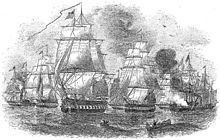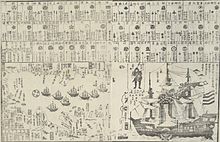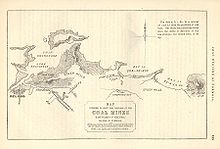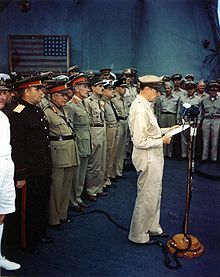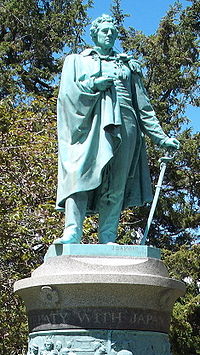- Matthew C. Perry
-
For other people with the same name, see Matthew Perry (disambiguation).
Matthew Calbraith Perry 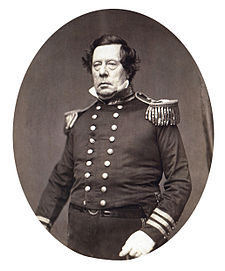
Matthew C. Perry c. 1856-58, in a photograph by Mathew Brady.Born April 10, 1794 Died March 4, 1858 (aged 63)
New York CityAllegiance  United States of America
United States of AmericaService/branch  United States Navy
United States NavyYears of service 1809-1855 Commands held USS Shark
Africa Squadron
USS Fulton
New York Navy Yard
USS Mississippi
Mosquito FleetBattles/wars Little Belt Affair
War of 1812- USS President vs HMS Belvidere
- Battle of Lake Erie
Second Barbary War
Suppression of the Slave Trade- Battle of Little Bereby
Opening of Japan
Mexican-American War- Battle of Frontiera
- First Battle of Tabasco
- Tampico Expedition
- Siege of Veracruz
- First Battle of Tuxpan
- Second Battle of Tuxpan
- Third Battle of Tuxpan
- Second Battle of Tabasco
Matthew Calbraith Perry [Note 1] (April 10, 1794 – March 4, 1858) was the Commodore of the U.S. Navy and served commanding a number of US naval ships. He served several wars, most notably in the Mexican-American War and the War of 1812. He played a leading role in the opening of Japan to the West with the Convention of Kanagawa in 1854. Perry was very concerned with the education of naval officers and helped develop an apprentice system that helped establish a naval curriculum at the United States Naval Academy. With the advent of the steam engine he was also a leading advocate of modernizing the U.S. Navy and came to be considered the The Father of the Steam Navy.
Contents
Matthew Perry was the son of Navy Captain, Christopher R. Perry and the younger brother of Oliver Hazard Perry. Matthew Perry received a midshipman's commission in the Navy in 1809, and was initially assigned to the USS Revenge, under the command of his elder brother. Under his brother's command, Matthew was a combatant in The Battle of Lake Erie aboard the Flagship Lawrence and the replacement flagship, Niagara.
Matthew's early career saw him assigned to several ships, including the USS President where he served as and aid to Commodore John Rodgers (1772–1838), which had been in a victorious engagement over a British vessel, HMS Little Belt, shortly before the War of 1812 was officially declared. He continued in this capacity during the War of 1812. Perry was also aboard the President when it engaged the HMS Belvidera when Rodgers himself fired the first shot of the war at this vessel with a following shot that resulted in a cannon bursting, wounding Rodgers and Perry and killing and wounding others. [1] Perry transferred to the USS United States, and saw little fighting in the war after that, since the ship was trapped in port at New London, Connecticut. Following the signing of the Treaty of Ghent which ended the conflict, he served on various vessels in the Mediterranean. Perry served under Commodore William Bainbridge during the Second Barbary War. He then served in African waters aboard USS Cyane during its patrol off Liberia from 1819-1820. After that cruise, Perry was sent to suppress piracy and the slave trade in the West Indies. Later during this period, while in port in Russia, Perry was offered a commission in the Imperial Russian Navy, which he declined.
Command assignments, 1820s-1840s
Opening of Key West
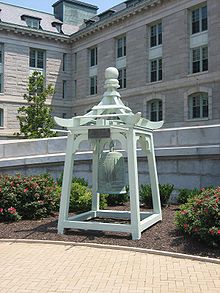 An exact replica of the Gokoku-ji Bell which Commodore (Cdre.) Perry brought back from Japan as a gift from the Ryukyuan Government. Currently stationed at the entrance of Bancroft Hall at the United States Naval Academy in Annapolis, MD. The original bell was returned to Japan in 1987.
An exact replica of the Gokoku-ji Bell which Commodore (Cdre.) Perry brought back from Japan as a gift from the Ryukyuan Government. Currently stationed at the entrance of Bancroft Hall at the United States Naval Academy in Annapolis, MD. The original bell was returned to Japan in 1987.
Perry commanded the USS Shark, a schooner with 12 guns, from 1821-1825. In 1763, when Britain possessed Florida, the Spanish contended that the Florida Keys were part of Cuba and North Havana. Certain elements within the United States felt that Key West (which was then named Cayo Hueso, meaning "Bone Key") could potentially be the "Gibraltar of the West" because it guarded the northern edge of the 90 mile (145 km) wide Straits of Florida -- the deep water route between the Atlantic and the Gulf of Mexico.
In 1815 the Spanish governor in Havana deeded the island of Key West to Juan Pablo Salas of Saint Augustine. After Florida was transferred to the United States, Salas sold Key West to U.S. businessman John W. Simonton for $2,000 in 1821. Simonton lobbied the U.S. Government to establish a naval base on Key West, both to take advantage of its strategic location and to bring law and order to the area.
On March 25, 1822, Perry sailed the Shark to Key West and planted the U.S. flag, physically claiming the Keys as United States property.
Perry renamed Cayo Hueso "Thompson's Island" for the Secretary of the Navy Smith Thompson and the harbor "Port Rodgers" for the president of the Board of Navy Commissioners. Neither name stuck.
From 1826-1827 Perry acted as fleet captain for Commodore Rodgers. Perry returned to Charleston, South Carolina for shore duty in 1828, and in 1830 took command of a sloop-of-war, the USS Concord. He spent the years 1833-1837 as second officer of the New York Navy Yard (later the Brooklyn Navy Yard), gaining promotion to captain at the end of this tour.
He was a member of the Masons.[2]
Perry had an ardent interest and saw the need for the naval education, supporting an apprentice system to train new seamen, and helped establish the curriculum for the United States Naval Academy. He was a vocal proponent of modernizing the Navy. Once promoted to captain, he oversaw construction of the Navy's second steam frigate the USS Fulton, which he commanded after its completion. He was called "The Father of the Steam Navy",[3] and he organized America's first corps of naval engineers, and conducted the first U.S. naval gunnery school while commanding Fulton in 1839-1841 off Sandy Hook on the coast of New Jersey.
Promotion to Commodore
Perry received the title of Commodore in June 1840, when the Secretary of the Navy appointed him commandant of New York Navy Yard.[4] The United States Navy did not have ranks higher than captain until 1862, so the title of commodore carried considerable importance.[5] Officially, an officer would revert to his permanent rank after the squadron command assignment had ended, although in practice officers who received the title of commodore retained the title for life, and Perry was no exception.
During his tenure in Brooklyn, he lived in Quarters B at Admiral's Row, a building which still stands today, but is threatened with demolition by the Brooklyn Navy Yard Development Corporation. In 1843, Perry took command of the African Squadron, whose duty was to interdict the slave trade under the Webster-Ashburton Treaty, and continued in this endeavor through 1844.
Mexican-American War
In 1845, Commodore David Connor's length of service in command of the Home Squadron had come to an end. However, the coming of the Mexican-American War persuaded the authorities not to change commanders in the face of the war. Perry, who would eventually succeed Connor, was made second-in-command and captained the USS Mississippi. Perry captured the Mexican city of Frontera, demonstrated against Tabasco and took part in the Tampico Expedition. He had to return to Norfolk, Virginia to make repairs and was still there when the amphibious landings at Veracruz took place. His return to the U.S. gave his superiors the chance to finally give him orders to succeed Commodore Connor in command of the Home Squadron. Perry returned to the fleet during the siege of Veracruz and his ship supported the siege from the sea. After the fall of Veracruz Winfield Scott moved inland and Perry moved against the remaining Mexican port cities. Perry assembled the Mosquito Fleet and captured Tuxpan in April, 1847. In July 1847 he attacked Tabasco personally, leading a 1,173-man landing force ashore and attacking the city from land.[6]
The Perry Expedition: Opening of Japan, 1852-1854
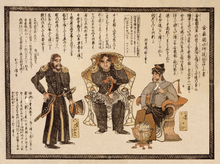 Japanese woodblock print of Perry (center) and other high-ranking American seamen
Japanese woodblock print of Perry (center) and other high-ranking American seamen See also: Late Tokugawa shogunate
See also: Late Tokugawa shogunateIn advance of his voyage to the Far East, Commodore Perry read widely amongst available books about Tokugawa Japan. His research even included consultation with the increasingly well-known Japanologist Philipp Franz von Siebold, who had lived on the Dutch island of Dejima for eight years before retiring to Leiden in the Netherlands.[7]
Precedents
Perry's expedition to Japan was preceded by several naval expeditions by American ships:
- From 1797 to 1809, several American ships traded in Nagasaki under the Dutch flag, upon the request of the Dutch, who were not able to send their own ships because of their conflict against Britain during the Napoleonic Wars. Japan limited foreign trade to the Dutch and Chinese at that time, under the policy of sakoku.
- In 1837, an American businessman in Canton named Charles W. King saw an opportunity to open trade by trying to return to Japan three Japanese sailors (among them, Otokichi) who had been shipwrecked a few years before on the coast of Washington. He went to Uraga Channel with Morrison, an unarmed American merchant ship. The ship was attacked several times, and sailed back without completing its mission.
- In 1846, Commander James Biddle, sent by the United States Government to open trade, anchored in Tokyo Bay with two ships, including one warship armed with 72 cannons, but his requests for a trade agreement remained unsuccessful.[8]
- In 1849, Captain James Glynn sailed to Nagasaki, leading at last to the first successful negotiation by an American with "Closed Country" Japan. James Glynn recommended to the United States Congress that negotiations to open Japan be backed up by a demonstration of force, thus paving the way for Perry's expedition.[9]
First visit, 1852-1853
 Odaiba battery at the entrance of Tokyo, built in 1853-54 to prevent an American intrusion
Odaiba battery at the entrance of Tokyo, built in 1853-54 to prevent an American intrusion
 One of the cannons of Odaiba, now at the Yasukuni Shrine. 80-pound bronze, bore: 250mm, length: 3830mm.
One of the cannons of Odaiba, now at the Yasukuni Shrine. 80-pound bronze, bore: 250mm, length: 3830mm.
In 1852, Perry embarked from Norfolk, Virginia for Japan, in command of the East India Squadron in search of a Japanese trade treaty. Aboard a black-hulled steam frigate, he ported Mississippi, Plymouth, Saratoga, and Susquehanna at Uraga Harbor near Edo (modern Tokyo) on July 8, 1853. His actions at this crucial juncture were informed by a careful study of Japan's previous contacts with Western ships and what could be known about the Japanese hierarchical culture. He was met by representatives of the Tokugawa Shogunate who told him to proceed to Nagasaki, where there was limited trade with the Netherlands and which was the only Japanese port open to foreigners at that time (see Sakoku).
Threat of force and negotiation
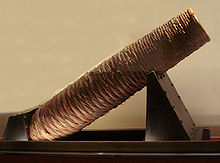 Japanese coastal wooden cannon built by the Daimyos at the Bakufu's order for Commodore Perry's arrival. 1853-54.
Japanese coastal wooden cannon built by the Daimyos at the Bakufu's order for Commodore Perry's arrival. 1853-54.
As he arrived, Perry ordered his ships to steam past Japanese lines towards the capital of Edo, and position their guns towards the town of Uraga.[10] Perry refused to abide to demands to leave.[10] He then demanded permission to present a letter from President Millard Fillmore, and threatened to use force if the Japanese boats around the American squadron did not disperse.[10]
Perry attempted to intimidate the Japanese by presenting them a white flag and a letter which told them that in case they chose to combat, the Americans would necessarily vanquish them.[11][12] Perry's ships were equipped with new Paixhans shell guns, capable of wreaking great destruction with every shell.[13][14] The term "Black Ships", in Japan, would later come to symbolize a threat imposed by Western technology.[15]
After the Japanese agreed to receive the letter from the American President, Perry landed at Kurihama (in modern-day Yokosuka) on July 14, 1853[16] presented the letter to delegates present, and left for the Chinese coast, promising to return for a reply.[17]
Fortifications were built in Tokyo Bay at Odaiba in order to protect Edo from possible American naval incursion.
Second visit, 1854
Perry returned in February 1854 with twice as many ships, finding that the delegates had prepared a treaty embodying virtually all the demands in Fillmore's letter. Perry signed the Convention of Kanagawa on March 31, 1854 and departed, mistakenly believing the agreement had been made with imperial representatives.[18] The agreement was made with the Shogun, the de facto ruler of Japan.
On his way to Japan, Perry anchored off Keelung in Formosa (modern day Taiwan), for ten days. Perry and crew members landed on Formosa and investigated the potential of mining the coal deposits in that area. He emphasized in his reports that Formosa provided a convenient mid-way trade location. Formosa was also very defensible. It could serve as a base for exploration as Cuba had done for the Spanish in the Americas. Occupying Formosa could help the US to counter European monopolization of the major trade routes. President Franklin Pierce declined the suggestion, remarking such a remote possession would be an unnecessary drain of resources and that he would be unlikely to receive the consent of Congress.
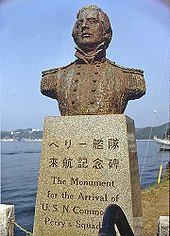 Bust of Matthew Perry in Shimoda, Shizuoka
Bust of Matthew Perry in Shimoda, Shizuoka
Return to the United States, 1855
When Perry returned to the United States in 1855, Congress voted to grant him a reward of $20,000 in appreciation of his work in Japan. Perry used part of this money to prepare and publish a report on the expedition in three volumes, titled Narrative of the Expedition of an American Squadron to the China Seas[disambiguation needed
 ] and Japan. He was also advanced to the grade of rear-admiral on the retired list (when his health began to fail) as a reward for his services in the Far East.[19] Perry was known to have suffered severe arthritis that left him in frequent pain, that on occasion precluded him from his duties.[20]
] and Japan. He was also advanced to the grade of rear-admiral on the retired list (when his health began to fail) as a reward for his services in the Far East.[19] Perry was known to have suffered severe arthritis that left him in frequent pain, that on occasion precluded him from his duties.[20]Last years
Perry spent his last years preparing for publication his account of the Japan expedition, announcing its completion on December 28, 1857. Two days later he was detached from his last post, an assignment to the Naval Efficiency Board. He died awaiting further orders on March 4, 1858 in New York City, of rheumatism that had spread to the heart, compounded by complications of gout.[21]
Initially interred in a vault on the grounds of St. Mark's Church in-the-Bowery, in New York City, his remains were moved to the Island Cemetery in Newport, Rhode Island on March 21, 1866,[22] along with those of his daughter, Anna, who died in 1839.
A diplomatic note
Among other mementos, Perry presented Queen Victoria with a breeding pair of Japanese Chin dogs, previously owned only by Japanese nobility.
Perry's flag and legacy
A replica of Perry's US flag is on display on board the USS Missouri (BB-63) memorial in Pearl Harbor, Hawaii. It is attached to the bulkhead just inboard of the Japanese surrender signing site on the port side of the ship. The original flag was brought from the U.S. Naval Academy Museum to Japan for the Japan surrender ceremony and was displayed on that occasion at the request of Douglas MacArthur, who was himself a blood-relative of Perry. Some photographs of the signing ceremony show that this flag was actually displayed backward—reverse side showing (stars in the upper right corner). The cloth of the historic flag was so fragile that the conservator at the Museum directed that a protective backing be sewn on it, leaving its "wrong side" visible; and this was how Perry's 31-star flag was presented on this unique occasion.[23] Today, the flag is preserved and on display at the Naval Academy Museum in Annapolis, Maryland.
The pattern for the Union canton on this flag is different from the standard 31-star flag then in use. Perry's flag had columns of five stars save the last column which had six stars. Perry's US flag was unique when it was first flown in Tokyo Bay in 1853-1854. A replica of this historic flag can be seen today on the Surrender Deck of the Battleship Missouri Memorial in Pearl Harbor. This replica is also placed in the same location on the bulkhead of the veranda deck where it had been initially mounted on the morning of September 2, 1945[23] by Chief Carpenter Fred Miletich.[24]
Memorials
- In his birthplace, Newport, Rhode Island, there is a memorial plaque in Trinity Church, Newport, and a statue of Perry in Touro Park designed by John Quincy Adams Ward erected in 1869 and dedicated by his daughter. He was buried in Newport's Island Cemetery, near his parents and brother. There are also exhibits and research collections concerning his life at the Naval War College Museum and at the Newport Historical Society.
- There is a Perry Park in Kurihama, Japan which has a monolith monument (dedicated July 14, 1901) to the landing of Perry's forces.[25] Within the park there is a small museum dedicated to the events of 1854. Admission is free, and the museum is open from 10 a.m. to 4 p.m., seven days a week.
- Matthew C. Perry Elementary and High School can be found on Marine Corps Air Station, Iwakuni, Japan.
- The U.S. Navy's Perry-class frigates (purchased in the 1970s and 1980s) were named after Perry's brother, Commodore Oliver Hazard Perry.
- On December 2, 2008, Secretary of the Navy Donald C. Winter announced that the ninth ship of the Lewis and Clark class of dry-cargo-ammunition vessels would be named USNS Matthew Perry (T-AKE-9) for Commodore Perry.
Fictional depictions
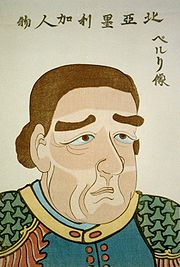 Japanese woodblock print of Commodore Perry, c. 1854. The caption reads "North American" (top line, written from right to left in Chinese character) and "Perry's portrait" (first line, written from top to bottom).
Japanese woodblock print of Commodore Perry, c. 1854. The caption reads "North American" (top line, written from right to left in Chinese character) and "Perry's portrait" (first line, written from top to bottom).
- The story of the opening of Japan was the basis of Stephen Sondheim & John Weidman's Pacific Overtures.
- Actor Richard Boone played Commodore Perry in the highly fictionalized 1981 film The Bushido Blade.
- The coming of Commodore Perry's ships was indirectly part of a plot in one of the arcs of the anime series Rurouni Kenshin, and in the first episode of Hikaru no Go. Another anime series in which Perry briefly appears is Bokusatsu Tenshi Dokuro-chan. The manga Fruits Basket also refers to the event while the main character is studying. The anime Sayonara Zetsubou Sensei also depicts Commodore Perry as a "troubled foreigner who isn't satisfied by opening ports and needs to open everything".
- The anime series, Samurai Champloo, in an episode entitled "Baseball Blues", depicts a fictional character named 'Admiral Joy Cartwright' who challenges the Japanese locals to a baseball (Yakyū) game in order to establish trade relations. The character is named after Alexander Joy Cartwright ("the father of baseball") and obviously modeled after Commodore Perry.
- Perry's visit is also mentioned in the 1965 Hideo Gosha film Sword of the Beast.
- The faster-than-light spaceship in the novel Homeward Bound is named Commodore Perry.
- Popotan has several references to Perry throughout the series.
- The 2010 NHK Taiga drama Ryōmaden, which deals with the Bakumatsu period, portrayed Perry as a menacing, steadfast military commander who was able to subjugate the then-seemingly invincible Bakufu through blunt negotiation. He was played by Timothy Harris.
- Perry is the main antagonist in the Code Geass alternate universe manga "Tales of an Alternate Shogunate". He uses Geass to force Japan to open its ports, but does so on unequal terms and oppresses Japan, much like Britannia did in the original series. He faces opposition from Zero and the Black Knights, as well as from Princess Euphemia and Suzaku after they realize that he is trying to make Japan his own property, and he is ultimately defeated and forced to surrender. He pilots the "Black Ship" a flying ship that can transform into a combat robot.
See also
References
- ^ Griffis, 1887 p.40
- ^ Famous Masons
- ^ Sewall, John S. (1905). The Logbook of the Captain's Clerk: Adventures in the China Seas, p. xxxvi.
- ^ Griffis, William Elliot. (1887). Matthew Calbraith Perry: A Typical American Naval Officer, pp. 154-155.
- ^ "Commodore". United States Navy. http://www.history.navy.mil/trivia/triv4-5k.htm. Retrieved 2009-12-14.
- ^ Sewell, p. xxxvi.
- ^ Sewall, p. xxxviii.
- ^ Sewell, pp. xxxiv-xxxv, xlix, lvi.
- ^ English Wikipedia on Preble Logbook
- ^ a b c The Perry mission to Japan, 1853 - 1854 by William Gerald Beasley, Aaron Haight Palmer, Henry F. Graff, Yashi Shōzan, Ernest Mason Satow, Shuziro Watanabe p.153ff
- ^ "Among the items presented to the Japanese were a white flag and a letter from Perry. The letter attempted to intimidate Japanese officials by explaining that in the event the Japanese elected war rather than negotiation, they could use the white flag to sue for peace, since victory would naturally belong to the Americans"Matthew Calbraith Perry: antebellum sailor and diplomat by John H. Schroeder p.286 Note 44
- ^ The economic aspects of the history of the civilization of Japan Yosaburō Takekoshi p.285-86 [1]
- ^ Arms and men: a study in American military history Walter Millis p.88 [2]
- ^ Black Ships Off Japan - The Story of Commodore Perry's Expedition Arthur Walworth p.21 [3]
- ^ Sewall, pp. 167-183.
- ^ "Perry Ceremony Today; Japanese and U. S. Officials to Mark 100th Anniversary." New York Times. July 14, 1953,
- ^ Sewall, pp. 183-195.
- ^ Sewall, pp. 243-264.
- ^ Sewall, p. lxxxvii.
- ^ "Commodore Perry's Expedition to Japan". Ben Griffiths 2005. http://www.grifworld.com/perryhome.html. Retrieved September 12, 2009.
- ^ Morison, Samuel Eliot. (1967). 'Old Bruin' Commodore Matthew Calbraith Perry p. 431.
- ^ "Matthew Calbraith Perry (1794-1858) - Find a Grave Memorial". http://www.findagrave.com/cgi-bin/fg.cgi?page=gr&GRid=804. Retrieved January 9, 2011.
- ^ a b Tsustsumi, Cheryl Lee. "Hawaii's Back Yard: Mighty Mo memorial re-creates a powerful history," Star-Bulletin (Honolulu). August 26, 2007.
- ^ Broom, Jack. "Memories on Board Battleship," Seattle Times. May 21, 1998.
- ^ Sewall, pp. 197–198.
Bibliography
- Cullen, Louis M. (2003). A History of Japan, 1582-1941: Internal and External Worlds. Cambridge: Cambridge University Press. ISBN 0-521-82115-X (cloth) ISBN 0-521-529918-2 (paper)
- Griffis, William Elliot (1887). Matthew Calbraith Perry: a typical American naval officer.
Cupples and Hurd, Boston. pp. 459. ISBN 116363493X.}} Url - Hawks, Francis. (1856). Narrative of the Expedition of an American Squadron to the China Seas and Japan Performed in the Years 1852, 1853 and 1854 under the Command of Commodore M.C. Perry, United States Navy. Washington: A.O.P. Nicholson by order of Congress, 1856; originally published in Senate Executive Documents, No. 34 of 33rd Congress, 2nd Session. [reprinted by London:Trafalgar Square, 2005. ISBN 1-84588-026-9 (paper)]
- Sewall, John S. (1905). The Logbook of the Captain's Clerk: Adventures in the China Seas. Bangor, Maine: Chas H. Glass & Co. [reprint by Chicago: R.R. Donnelly & Sons, 1995] ISBN 0-548-20912-X
Notes
- ^ Perry's middle name is often misspelled as Galbraith instead of Calbraith
Further reading
- Perry, Matthew Calbraith. (1856). Narrative of the expedition of an American Squadron to the China Seas and Japan, 1856. New York : D. Appleton and Company. digitized by University of Hong Kong Libraries, Digital Initiatives, "China Through Western Eyes."
External links
Categories:- 1794 births
- 1858 deaths
- American Commodores
- American expatriates in Japan
- Edo period
- History of Key West, Florida
- American people of English descent
- American people of Scottish descent
- American military personnel of English descent
- American military personnel of Scottish descent
- People from Newport, Rhode Island
- People from New York City
- People from Rhode Island in the War of 1812
- Perry family
- United States Navy officers
- Meiji Restoration
Wikimedia Foundation. 2010.


